Materials and methods
This study investigated the effectiveness of the EPI-C Plus main unit (Espansione Marketing Spa, Italy), an innovative 840–880 nm LED facial mask developed to induce skin photobiomodulation (Figure 1) and cleared by the Food and Drug Administration (FDA). Treatment protocol was also approved by the Continuous Dermatologic Education Committee (CDEC) Review Board (Trieste, Italy), and comprises a sequential combination of CW 835±5 nm followed by PW narrow-band 875±5nm LED light facial mask for the treatment of premature ageing.
Subjects
Ten healthy female subjects with premature ageing with no previously performed invasive and/or non-invasive anti-ageing procedures, were recruited between March and April 2011 according to a protocol approved by the CACD Review Board. Ages ranged from 47 to 77 years with a median age of 55 years. Inclusion criteria were:
-
Fitzpatrick skin types I–III presenting with mild-to-moderate facial premature ageing (score 1.5–2.5 on modified Fitzpatrick wrinkle scale) 22
-
Positively oriented psychological attitude to improve skin appearance and function
-
Realistic expectations concerning clinical results after mild, non-invasive procedures.
Exclusion criteria included:
-
Pregnancy
-
Important facial scarring from previous inflammatory and/or traumatic diseases
-
Recent sunburns
-
Topical anti-ageing treatments within 6 months prior to treatment
-
Laser/IPL
-
Chemical peel
-
Cosmetic facial surgery within 12 months prior to treatment.
Full patient consent to participate in the study was obtained using an IR-B approved protocol and consent form. Body mass index (BMI) was calculated during all scheduled clinical appointments for each subject in order to monitor the stability of their general metabolism for the duration of the study. In fact, weight gain could sensitively decrease lines and wrinkles on the face, thus leading to an important bias in this kind of pilot study.
Treatment
All subjects were asked to temporarily suspend routinely applied topical facial products 15 days prior to initiation of treatment. A standardised skincare regimen was prescribed during the 15-day pre-treatment ‘wash-out period’ according to the following:
-
Ictyane cleansing cream (Ducray Laboratoires Dermatologique, Pierre Fabre, France) — one application twice daily
-
Thermal spring water mist (Avne, Pierre Fabre, France) — one mist twice daily immediately before moisturising cream
-
Ictyane moisturising cream (Ducray Laboratoires Dermatologique, Pierre Fabre, France) — one application twice daily immediately after Thermal spring water
-
Anthelios SPF 50+ cream (La Roche Posay Laboratoires Dermatologique, France) — one application every morning on top of moisturising cream, to be repeated every 2 hours in cases of prolonged UV exposure.
The same skincare regimen was maintained for the duration of LED treatment, and represents a standard hydrating protocol with creams with hydrating properties and none with anti-ageing properties. This standardisation was introduced to avoid any bias from other anti-ageing creams eventually applied subjectively at home.
All patients received eight full-face LED treatments over a 1-month period. Two treatments were scheduled per week, with a minimal interval of 3 days between treatments. All patients were instructed not to wear any facial make-up from the night prior to treatment. Gentle facial cleansing with Ictyane cleansing cream was performed immediately pre-LED light exposure. Cleanser was rinsed off with lukewarm water. The LED facial mask was carefully positioned on facial skin and retaining straps were adjusted to obtain a perfect anatomical match between LED array and facial skin, keeping light source distance to an average of 5 mm (8±4 mm). Each treatment consisted of standardised 15 minute pre-set 835±5 nm CW LED (50%) plus 15 minute pre-set 875±5 nm PW LED (50%) exposures for a total irradiation dose of 66 J/cm2 per session (33 J/cm2 + 33 J/cm2).
Immediately post-treatment, Thermal spring water mist followed by Ictyane moisturising cream were applied to treated skin. All subjects were instructed to wear daily high SPF sunscreen, and minimise sun exposure. Make-up was allowed 1 hour after treatment.
Clinical photographs
Standardised clinical photographs were taken at baseline, immediately before the first LED exposure (T1), at 15 days (T2 - T1 + 45 days), and 45 days (T3 - T1 + 75 days) after completion of eight treatment sessions using a 10.5 megapixel EOS 1000D digital camera (Canon Inc, Tokyo, Japan), a EF-50 mm f/2.5 Compact-Macro lens (Canon Inc.), and a 220EX Speedlite dedicated TTL flash (Canon Inc.). In the aim to standardise templates, all subjects were asked to wash off any make-up before photographic sessions and rest sitting for 15 minutes at constant thermal comfort room parameters: temperature (23.5–25.5C) and relative humidity (50±5%). At the end of each photographic session an in vivo 3D photographic quantitative measurement of skin texture, wrinkles and superficial pigmented alterations was obtained using a Visia Complexion Analysis standardised photographic system with Visia 5 software (Canfield Imaging System, Canfield Scientific, NJ, USA).




